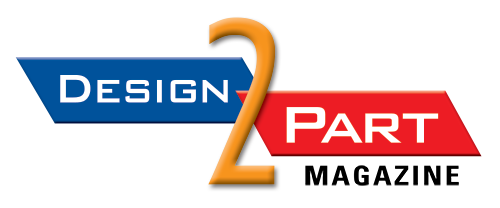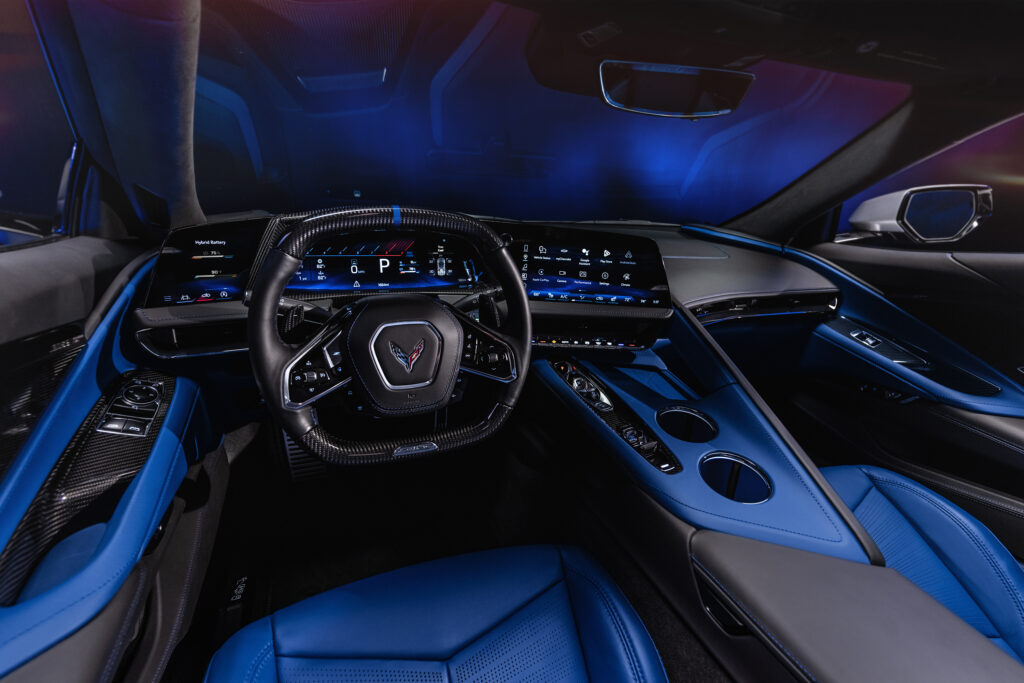
The Santorini Blue interior on 2026 Chevrolet Corvette ZRX1. (Photo courtesy General Motors)
Mark Shortt
From digital taillights to custom infotainment systems and new alternatives to traditional shock absorbers, automakers are continuing to build cars that combine software and hardware in innovative ways. For drivers and passengers, the payoffs include increased safety, performance, and comfort.
On the 2026 Corvette, for example, designers have seamlessly integrated updated hardware and software to enhance the car’s bespoke (custom-made) cockpit and built-in infotainment system, according to a release from General Motors. That integration is evident in three new configurable driver-centric displays that are larger while offering sharper colors, more agility, and added functionality.
It’s also apparent in a new 6.6-inch diagonal touchscreen auxiliary display that offers driver-configurable space for instrumentation like trip mileage or Performance Traction Management, enabling drivers to access important information more easily.
“There’s an intentional balance of physical and virtual controls,” said Dusty Smith, performance driving product manager, in a statement. “For example, the head-up display controls are now virtualized, which opens space for Performance Traction Management controls to be intuitive physical buttons. The technology in the new Corvette is as strong and capable as the engine behind you.”
In the vehicle manufacturing process, innovation is increasingly taking the form of flexible platforms that enable rapid scale up of production along with customization for different vehicle configurations. It could be an autonomous platform for trucks that combines AI software with modular, vehicle-agnostic hardware, or a flexible approach that enables the automaker to build internal combustion engine (ICE), hybrid-electric, and battery electric vehicles (EVs) on the same production lines.
The articles ahead highlight some of the ways that automotive designers and manufacturers are reimagining products and processes to bring innovative vehicles to market.
Manufacturing Partnership Focuses on Upfitting Autonomous Trucks Equipped with AI Software, Modular Hardware Platform
Roush Industries is working with Kodiak Robotics to develop a scalable process for customizing the vehicles to meet customer needs.
MOUNTAIN VIEW, Calif. and LIVONIA, Mich.— Kodiak Robotics, Inc., and Roush Industries, Inc., will work together to scale the upfitting (customization) of autonomous trucks equipped with Kodiak’s AI-powered autonomous platform, the companies said in a joint release.
Kodiak Robotics is a provider of AI-powered autonomous vehicle technology. Roush Industries is a product development supplier that serves the mobility, aerospace, defense, and theme park industries.
The platform, called the Kodiak Driver, “combines advanced AI and modular hardware in a system designed to integrate seamlessly across vehicle platforms—enabling scalable autonomy in real-world conditions,” according to a statement on Kodiak Robotics’ website.
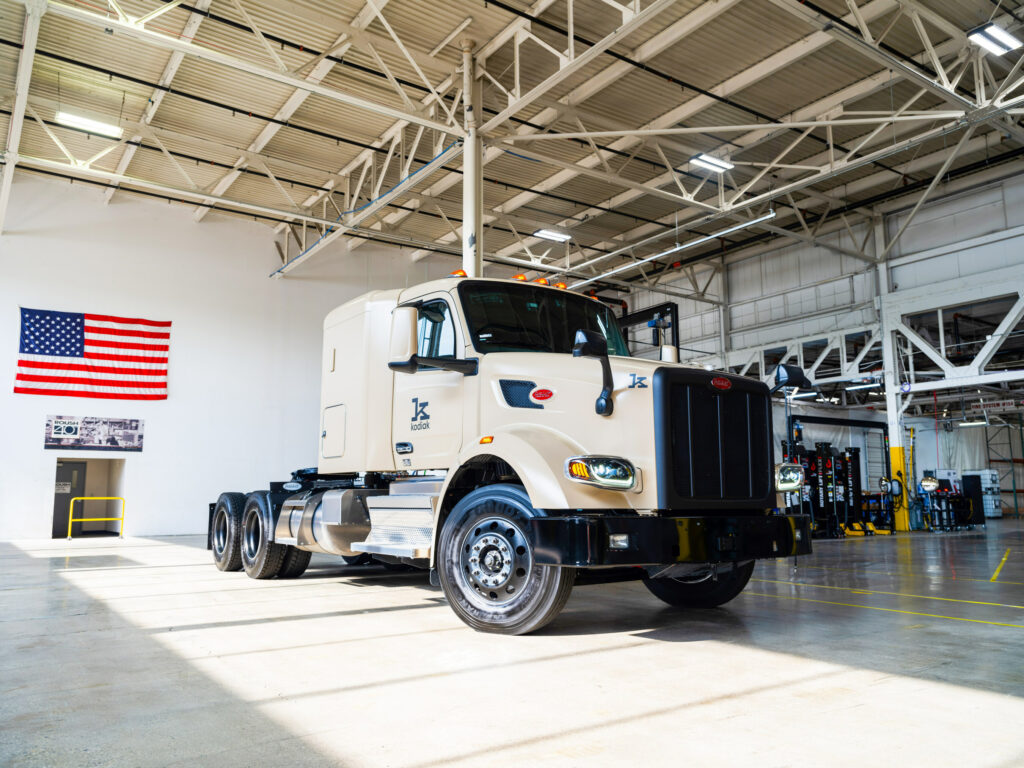
A Kodiak Driver-equipped autonomous truck at Roush’s production facility in Livonia, Michigan. (Photo courtesy Kodiak Robotics/Roush Industries/PRNewswire)
Roush will begin upfitting the trucks at its facility in Livonia in the second half of 2025. The first trucks that Roush will upfit are expected to be for Kodiak’s customer, Atlas Energy Solutions, as Kodiak and Atlas work to expand the driverless operations they began in December 2024.
Roush, in collaboration with Kodiak, committed to opening a production line for scaled upfitting of trucks equipped with the Kodiak Driver’s modular and vehicle-agnostic hardware. The hardware includes Kodiak’s proprietary SensorPods, AI compute, Actuation Control Engine safety compute, and redundant actuation elements.
“Unlike traditional factory-line integration, which is limited to a single configuration, we believe that working with Roush will allow us to move faster and customize vehicles to meet customer needs,” said Don Burnette, founder and CEO at Kodiak Robotics, in a statement.
Roush also committed to design, develop, and implement a flexible manufacturing process that can rapidly scale as Kodiak increases its upfitting of Kodiak Driver-powered trucks to meet customer demand, the release stated.
“Kodiak’s autonomous trucking technology is an exciting advancement in the mobility industry,” said Brad Rzetelny, vice president of contract manufacturing at Roush, in a statement. “Together, we’re working to build a robust and repeatable manufacturing process that supports Kodiak’s transition from limited production to full-scale deployment. Kodiak’s technology and engineering rigor set a high bar, and we believe we are uniquely positioned to meet that bar at scale.”
“We believe that Roush’s strong quality management processes will ensure our customers’ Kodiak Driver-powered trucks will be built to exacting standards, while giving us the manufacturing flexibility to support a wide range of vehicle configurations, including different vehicle and cab types, axle setups, and heavy-duty applications to meet the diverse demands of the trucking industry.”
— Don Burdette, CEO at Kodiak Robotics
Roush provides product development services that include systems integration, manufacturing, and modification. The company stated in the release that it has developed deep expertise in upfitting and delivering complex vehicles, including autonomous vehicles for multiple developers. Its demonstrated track record of bringing innovative products to market is said to “establish a strong foundation for Kodiak to scale the deployment of the Kodiak Driver.”
“Roush’s deep experience upfitting autonomous vehicles makes them an ideal production partner for Kodiak,” said Burnette. “We believe that Roush’s strong quality management processes will ensure our customers’ Kodiak Driver-powered trucks will be built to exacting standards, while giving us the manufacturing flexibility to support a wide range of vehicle configurations, including different vehicle and cab types, axle setups, and heavy-duty applications to meet the diverse demands of the trucking industry.”
According to Roush, it has “boldly imagined and created remarkable solutions for some of the world’s greatest organizations.”
“We dream, design, engineer, test, and deliver extraordinary products for customers in the advanced mobility, aerospace, defense, and theme park industries,” Roush stated in the release. “Roush is unique in its ability to leverage services across the complete product development cycle, solving customers’ most complex challenges and accelerating critical product launch targets.”
Kodiak Robotics, Inc., founded in 2018, provides “AI-powered autonomous vehicle technology that is designed to help tackle some of the toughest driving jobs,” the release stated. The company’s driverless technology aims to address the critical problem of safely transporting goods in the face of unprecedented supply chain challenges.
Kodiak’s vision is to become the trusted world leader in autonomous ground transportation. The company said it is “committed to a safer and more efficient future for all through the commercialization of driverless trucking at scale.”
“To that end, Kodiak developed the Kodiak Driver, a virtual driver that combines advanced AI-powered software with modular and vehicle-agnostic hardware designed to help address Kodiak’s customers’ needs,” the company said in the release.
In 2024, Kodiak achieved what it described as a historic milestone by becoming the first company to deploy customer-owned and operated driverless trucks in commercial service. The company said the Kodiak Driver is also being used in the public sector, where Kodiak believes it can support national security initiatives and critical government applications.
Fully Active Electromechanical Suspension Earns Marelli a 2025 Automotive News PACEpilot Award
Thanks to a smart algorithm, the system actively corrects and adapts to road irregularities and driving situations, ensuring stability and comfort.
DETROIT—At a ceremony held on April 15 in the Motor City, Marelli received a 2025 Automotive News PACEpilot Award for its Fully Active Electromechanical Suspension. The award “honors innovations by automotive suppliers that have not yet been commercialized but have the potential to revolutionize the future of mobility,” Marelli said in a release announcing the award.
The technology is based on an electromechanical system that actively manages the vertical dynamics of a vehicle’s suspension in a new way, offering an innovative alternative to traditional shock absorber systems. Benefits of the system are reported to include enhanced vehicle safety, improved performance and comfort, and high efficiency.
“The system autonomously defines the best behavior of each vehicle’s suspension, neutralizing vibration and vehicle body movements,” the release stated. “It consists of four electronically controlled actuators, which modulate each wheel’s suspension and damping parameters in real-time to provide optimal handling and ride comfort balance. Information is processed in only 5 milliseconds to determine, through a smart algorithm, the actions required under different conditions.”
In this way, the system actively corrects and adapts to road irregularities and driving situations, ensuring stability and comfort. This is said to help reduce motion sickness, especially during activities like reading or using a laptop. Both activities are expected to become more common with the rise of autonomous driving.
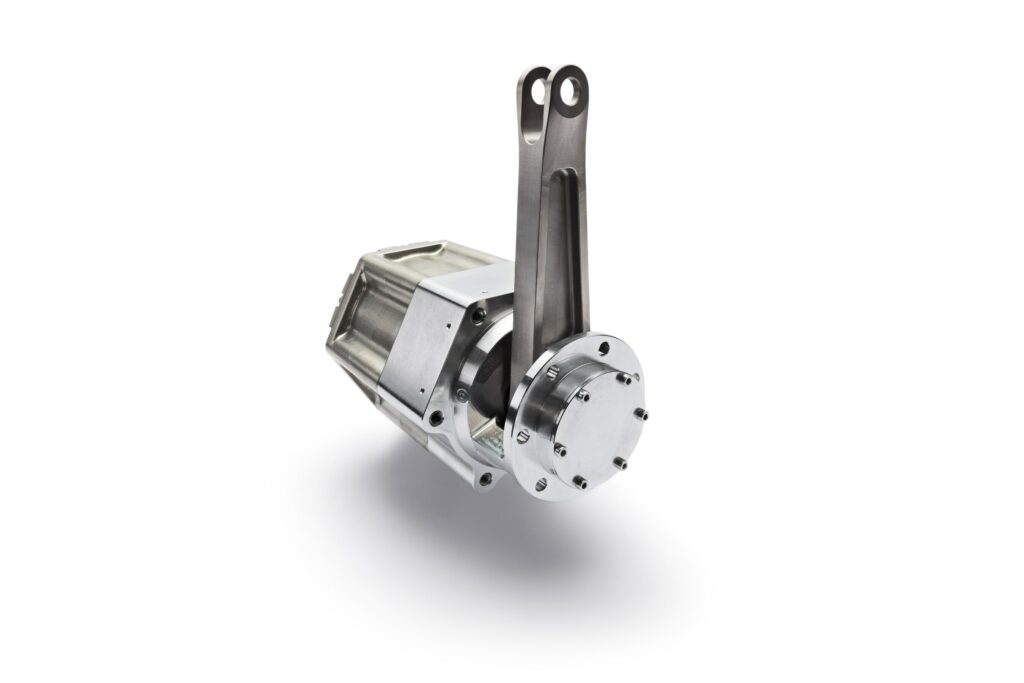
Marelli’s Fully Active Electromechanical Suspension. (Photo courtesy Marelli/PRNewswire)
Each of the four actuators is composed of a brushless motor and a high ratio reduction gear that connects to the suspension arm, with the ability to actively move the suspension. The motors are controlled by dedicated inverters, which receive the stroke target from a central unit hosting the vehicle dynamics software.
“This advanced software calculates the most suitable target action for each actuator based on the information collected from sensors (accelerometers and stroke sensors) that are mounted on the suspension, as well as from other electronically controlled systems installed in the car,” the company said in the release.
The system is entirely oil-free and designed for energy harvesting and electric power recovery. It reportedly achieves up to 80 percent energy efficiency compared to passive or semi-active systems. As a result, it can provide all of its functionality at nearly zero “energy cost” for the vehicle.
The technology is adaptable to various vehicle architectures, and its reduced volume and weight give carmakers more flexibility in design. It is also said to simplify manufacturing processes, decreasing time to market.
“It is with great pleasure and a touch of pride that I accept the highly coveted PACEpilot award,” stated Antonio Ferrara, president of Marelli’s Ride Dynamics business, in a prepared statement. “This award acknowledges our revolutionary, fully active electromechanical suspension technology and is a testament to our commitment to leading the rapid evolution of vehicle dynamics. We are proud to be an innovation partner for our customers around the world, thanks to our cutting-edge technological vision, which aims to enhance comfort and safety for high-end, hybrid, electric, and autonomous vehicles.”
Marelli is a global mobility technology supplier to the automotive sector. “With a strong and established track record in innovation and manufacturing excellence, our mission is to transform the future of mobility through working with customers and partners to create a safer, greener, and better-connected world,” the company stated in the release.
Honda EV Hub Preparing for a New Level of Flexible Production in a Reimagined Manufacturing Environment
More than $1 billion of investment positions Honda to build ICE, hybrid, and EV models on the same production line, the company said.
MARYSVILLE, Ohio—Honda has produced automobiles in Ohio for more than 40 years, going all the way back to when the company started producing cars at the Marysville Auto Plant (MAP) in November 1982.
The company established U.S. manufacturing operations in Marysville in 1979 with the start of motorcycle production. Today, more than 12,000 associates support Honda manufacturing in Ohio, according to a company release. Five plants are reported to represent a total capital investment of $13 billion and the capacity to produce 460,000 Honda and Acura automobiles, 1.18 million automobile engines, and more than 1 million automobile transmissions and two-motor hybrid systems, using domestic and globally sourced parts.
The company’s five Ohio manufacturing facilities include three auto plants: the Marysville Auto Plant, East Liberty Auto Plant, and Performance Manufacturing Center, and the Anna Engine Plant and transmission plant in Russells Point. Honda stated in the release that it has invested more than $1.4 billion in these facilities over the past six years, continually modernizing equipment and adopting new technologies to advance quality and efficiency for Honda and Acura customers here and around the world.
Now, Honda is establishing a new EV Hub for the start of its EV production in the United States. It is supported by more than $1 billion of investment to re-tool its existing auto and powertrain plants in Ohio for production of electric vehicles, as well as $3.5 billion to establish a joint venture EV battery plant with LG Energy Solution in Fayette County, Ohio.
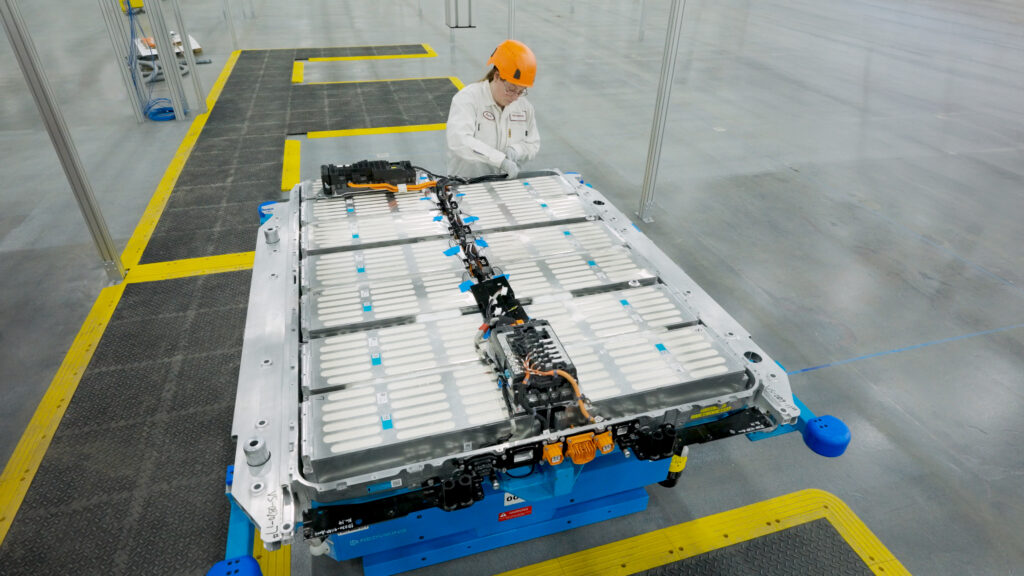
Honda’s plan to build ICE, hybrid, and EV models on the same production line is supported by more than $1 billion of investment. Retooled production facilities will provide an enhanced work environment for associates and even more sustainable production processes and equipment, the company said. (Photo courtesy Honda)
Earlier this year, Honda provided a first look at its innovative approach to manufacture electric vehicles (EV) by late 2025 at the Honda EV Hub in Ohio. The automaker detailed a flexible approach that enables Honda to build internal combustion engine (ICE), hybrid-electric, and battery electric vehicles (EVs) on the same production lines, the company said in the release.
“Honda created a flexible manufacturing system that enables the company to quickly and efficiently move production of products from one plant to another and to build multiple products on the same line,” the company’s website stated. “By staying flexible, Honda’s manufacturing plants can adjust to market demand while maximizing capacity, which helps to provide a stable production base for associates, dealers, and suppliers in America.”
In retooling its Marysville Auto Plant (MAP), East Liberty Auto Plant (ELP), and Anna Engine Plant (AEP), Honda said it has reimagined manufacturing to create what the company called “a work environment that is more human-friendly and environmentally responsible while achieving the highest levels of quality, efficiency and value for customers.”
“The Honda EV Hub provides Honda with the flexibility to produce ICE, hybrid-electric, and EV models on the same production lines so we can quickly respond to shifting customer needs and market conditions,” said Bob Schwyn, senior vice president, Honda Development & Manufacturing of America, LLC, in a statement. “Beyond adding the capability to produce EVs, we completely reimagined our approach to manufacturing, transforming the Honda production environment with more human-friendly processes and sustainable manufacturing practices.”
The Honda EV Hub is expected to begin EV production in late 2025 with the all-new Acura RSX EV, followed by Honda EV models based on the Honda 0 SUV and Honda 0 Saloon prototypes that the company debuted in January at CES 2025 in Las Vegas. Honda also introduced its original vehicle operating system (OS), the ASIMO OS, for use in Honda 0 Series models. The use of the ASIMO name pays homage to the Honda ASIMO robot and the “Wise” value of the Honda 0 Series, according to the release.
Honda announced plans to establish the Honda EV Hub in Ohio in October 2022, based on the company’s vision to make zero emissions vehicles represent 100 percent of its vehicle sales by 2040. Honda and LG Energy Solution committed to invest $3.5 billion in a new JV battery facility, L-H Battery Company, but the overall investment is projected to reach $4.4 billion. The facility will have an annual capacity of approximately 40 GWh, with production scheduled to start in late 2025, the company said in the release.
In addition to serving as the starting point for the global production of the new Honda 0 Series EVs, the Honda EV Hub is playing a critical role in developing the knowledge and expertise for EV technology and production to be shared with other Honda plants in North America and globally.
Honda engineers have used the opportunity of reimagining manufacturing at the Honda EV Hub to implement energy-saving and other environmentally responsible initiatives in line with the company’s Triple Action to Zero approach. Triple Action to Zero is a comprehensive strategy aimed at achieving zero environmental impact by 2050, through three critical action areas: carbon neutrality, clean energy, and resource circulation, the company said.
All three plants in the Honda EV Hub—MAP, ELP, and AEP—play pivotal roles in this initiative and have already begun adopting new processes and equipment to reduce the company’s environmental impact, the release stated.
